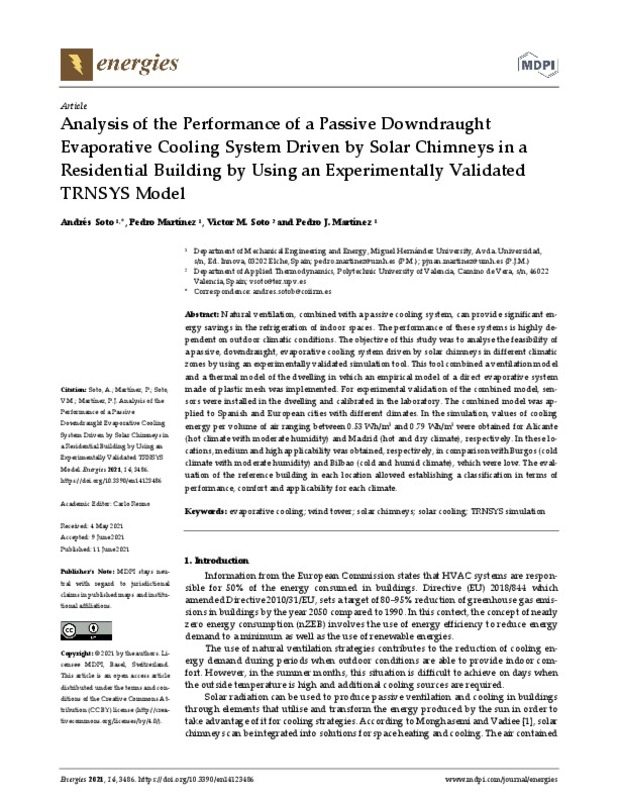JavaScript is disabled for your browser. Some features of this site may not work without it.
Buscar en RiuNet
Listar
Mi cuenta
Estadísticas
Ayuda RiuNet
Admin. UPV
Analysis of the Performance of a Passive Downdraught Evaporative Cooling System Driven by Solar Chimneys in a Residential Building by Using an Experimentally Validated TRNSYS Model
Mostrar el registro sencillo del ítem
Ficheros en el ítem
| dc.contributor.author | Soto, Andrés
|
es_ES |
| dc.contributor.author | Martínez, Pedro
|
es_ES |
| dc.contributor.author | Soto Francés, Víctor Manuel
|
es_ES |
| dc.contributor.author | Martínez, Pedro J.
|
es_ES |
| dc.date.accessioned | 2021-11-05T14:07:34Z | |
| dc.date.available | 2021-11-05T14:07:34Z | |
| dc.date.issued | 2021-06 | es_ES |
| dc.identifier.uri | http://hdl.handle.net/10251/176292 | |
| dc.description.abstract | [EN] Natural ventilation, combined with a passive cooling system, can provide significant energy savings in the refrigeration of indoor spaces. The performance of these systems is highly dependent on outdoor climatic conditions. The objective of this study was to analyse the feasibility of a passive, downdraught, evaporative cooling system driven by solar chimneys in different climatic zones by using an experimentally validated simulation tool. This tool combined a ventilation model and a thermal model of the dwelling in which an empirical model of a direct evaporative system made of plastic mesh was implemented. For experimental validation of the combined model, sensors were installed in the dwelling and calibrated in the laboratory. The combined model was applied to Spanish and European cities with different climates. In the simulation, values of cooling energy per volume of air ranging between 0.53 Wh/m(3) and 0.79 Wh/m(3) were obtained for Alicante (hot climate with moderate humidity) and Madrid (hot and dry climate), respectively. In these locations, medium and high applicability was obtained, respectively, in comparison with Burgos (cold climate with moderate humidity) and Bilbao (cold and humid climate), which were low. The evaluation of the reference building in each location allowed establishing a classification in terms of performance, comfort and applicability for each climate. | es_ES |
| dc.description.sponsorship | This research was funded by FEDER/Ministerio de Ciencia e Innovacion Agencia Estatal de Investigacion through Spanish research projects ENE2017-83729-C3-1-R and ENE2017-83729-C3-3-R, supported by FEDER funds. | es_ES |
| dc.language | Inglés | es_ES |
| dc.publisher | MDPI AG | es_ES |
| dc.relation.ispartof | Energies | es_ES |
| dc.rights | Reconocimiento (by) | es_ES |
| dc.subject | Evaporative cooling | es_ES |
| dc.subject | Wind tower | es_ES |
| dc.subject | Solar chimneys | es_ES |
| dc.subject | Solar cooling | es_ES |
| dc.subject | TRNSYS simulation | es_ES |
| dc.subject.classification | MAQUINAS Y MOTORES TERMICOS | es_ES |
| dc.title | Analysis of the Performance of a Passive Downdraught Evaporative Cooling System Driven by Solar Chimneys in a Residential Building by Using an Experimentally Validated TRNSYS Model | es_ES |
| dc.type | Artículo | es_ES |
| dc.identifier.doi | 10.3390/en14123486 | es_ES |
| dc.relation.projectID | info:eu-repo/grantAgreement/AEI/Plan Estatal de Investigación Científica y Técnica y de Innovación 2013-2016/ENE2017-83729-C3-1-R/ES/REDUCCION DEL CONSUMO DE ENERGIA EN EDIFICIOS MEDIANTE APLICACION DE ENERGIA SOLAR Y ENFRIAMIENTO EVAPORATIVO/ | es_ES |
| dc.relation.projectID | info:eu-repo/grantAgreement/AEI/Plan Estatal de Investigación Científica y Técnica y de Innovación 2013-2016/ENE2017-83729-C3-3-R/ES/MEJORA DE LA EFICIENCIA ENERGETICA DE SISTEMAS DE CLIMATIZACION EN EDIFICIOS MEDIANTE EL USO DE ACCIONES BIOCLIMATICAS Y DE SISTEMAS DE ENFRIAMIENTO EVAPORATIVO./ | es_ES |
| dc.rights.accessRights | Abierto | es_ES |
| dc.contributor.affiliation | Universitat Politècnica de València. Departamento de Termodinámica Aplicada - Departament de Termodinàmica Aplicada | es_ES |
| dc.description.bibliographicCitation | Soto, A.; Martínez, P.; Soto Francés, VM.; Martínez, PJ. (2021). Analysis of the Performance of a Passive Downdraught Evaporative Cooling System Driven by Solar Chimneys in a Residential Building by Using an Experimentally Validated TRNSYS Model. Energies. 14(12):1-17. https://doi.org/10.3390/en14123486 | es_ES |
| dc.description.accrualMethod | S | es_ES |
| dc.relation.publisherversion | https://doi.org/10.3390/en14123486 | es_ES |
| dc.description.upvformatpinicio | 1 | es_ES |
| dc.description.upvformatpfin | 17 | es_ES |
| dc.type.version | info:eu-repo/semantics/publishedVersion | es_ES |
| dc.description.volume | 14 | es_ES |
| dc.description.issue | 12 | es_ES |
| dc.identifier.eissn | 1996-1073 | es_ES |
| dc.relation.pasarela | S\439655 | es_ES |
| dc.contributor.funder | European Regional Development Fund | es_ES |
| dc.contributor.funder | Ministerio de Ciencia e Innovación | es_ES |
| dc.subject.ods | 07.- Asegurar el acceso a energías asequibles, fiables, sostenibles y modernas para todos | es_ES |








